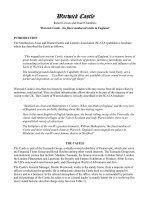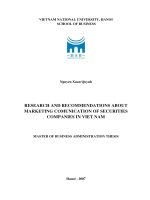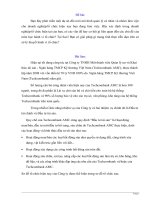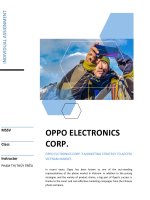individual assignment intergrated marketing comunication
Bạn đang xem bản rút gọn của tài liệu. Xem và tải ngay bản đầy đủ của tài liệu tại đây (2.33 MB, 16 trang )
<span class="text_page_counter">Trang 2</span><div class="page_container" data-page="2">
<b>2. Budgeting for the Promotional Program...3</b>
<b>IV. Chapter 11: Evaluation of Media: Television and Radio...4</b>
<b>1. Television Evaluation...4</b>
<b>1.1. Reach and Audience Demographics...4</b>
<b>1.2. Ratings and Share...4</b>
<b>1.3. Cost Efficiency and ROI...4</b>
<b>2. Radio Evaluation:...4</b>
<b>2.1. Reach and Listening Patterns...4</b>
<b>2.2. Frequency and Repetition...5</b>
<b>2.3. Cost Considerations...5</b>
<b>V. Chapter 12: Evaluation of Print Media...5</b>
<b>1. Evaluation of Print Media...5</b>
<b>1.1. Reach and Circulation...5</b>
<b>1.2. Target Audience and Demographics...6</b>
<b>1.3. Ad Placement and Design...6</b>
<b>1.4. Response and ROI...6</b>
<b>VI. Chapter 13: Support Media...6</b>
<b>1. Support Media...6</b>
<b>1.1. Definition and Purpose...6</b>
<b>1.2. Types of Support Media...7</b>
<b>VII. Conclusion... 7</b>
<b>VIII. References</b>...8
</div><span class="text_page_counter">Trang 4</span><div class="page_container" data-page="4">- The discussion revolves around crucial aspects of marketing andadvertising strategies, emphasizing the significance of effectivecommunication, goal-setting, and media evaluation. It delves into keyfactors influencing communication, including source credibility andmessage clarity, while highlighting the importance of aligningobjectives with broader business goals. Additionally, the allocation ofresources and budgeting for promotional programs is explored,emphasizing the need for flexibility and a balanced focus on short-termgains and long-term objectives. The evaluation of different mediatypes, such as television, radio, and print, is also examined,underscoring the importance of assessing reach, demographics, andreturn on investment. Together, these elements form a comprehensiveframework for businesses to connect with their target audience,optimize resources, and gauge the impact of their promotionalendeavors, ultimately contributing to overall business success.
- Credibility and Expertise: The credibility and expertise of the sourcegreatly influence how the message is received. People are more likelyto trust and pay attention to information from credible andknowledgeable sources.
- Attractiveness and Likeability: People are often more receptive tomessages delivered by individuals they find attractive or likable. Thiscan be applied in marketing, where companies use celebrities orrelatable figures to endorse their products.
- Authority and Status: Messages from figures of authority or high statustend to carry more weight.
</div><span class="text_page_counter">Trang 5</span><div class="page_container" data-page="5">- Clarity and Simplicity: Messages that are clear and easy to understandare more likely to be effective. Avoiding jargon and complex languageis important, especially when communicating with a diverse audience.- Relevance and Significance: Messages need to be relevant to the
receiver's interests or concerns
- Emotion and Persuasion: Emotions play a significant role incommunication. Messages that evoke emotions are more likely to beremembered and acted upon.
- Medium and Channel Selection: The choice of medium (e.g, face, email, phone call) affects how a message is received.
face-to-- Feedback and Interaction: Effective communication involves a two-wayexchange. Providing opportunities for feedback and interaction allowsfor clarification and ensures the message is understood correctly.- Noise and Distractions: External factors that interfere with the
transmission of the message are known as noise. This could beanything from a loud environment to technical glitches during a videoconference. Minimizing noise is crucial for effective communication.
<b>Application Examples:</b>
Nike - "Dream Crazy" Campaign
<small> class="text_page_counter">Trang 6</span><div class="page_container" data-page="6">
- Credibility and Trustworthiness: Nike is a globally recognized andtrusted brand in the sportswear industry.
- Relevance and Alignment: The campaign targets athletes andindividuals with a passion for sports and achieving their dreams.
<b>Message Factors:</b>
- Inspiring Storytelling: The ad features Colin Kaepernick, known for hisactivism in sports, and delivers a powerful message about overcomingchallenges and pursuing dreams.
- Bold Statement: The ad encourages viewers to "believe in something,even if it means sacrificing everything," aligning with Nike'scommitment to social causes.
<b>Channel Factors:</b>
- YouTube: The campaign's video ad was strategically placed onYouTube, a platform popular for video content and reaching a wideaudience.
- Social Media: Nike leveraged its strong presence on platforms likeInstagram and Twitter to promote the campaign and engage with itsaudience.
<b>Promotional Program. </b>
- Clear and Specific Goals: Objectives should be specific, measurable,achievable, relevant, and time-bound (SMART). This provides a cleardirection for the promotional program and enables evaluation of itseffectiveness.
- Align with Overall Business Goals: Promotional objectives shouldalign with the broader business objectives.
</div><span class="text_page_counter">Trang 7</span><div class="page_container" data-page="7">- Consideration of Target Audience: Objectives should take intoaccount the characteristics, preferences, and behaviors of thetarget audience.
- Short-term and Long-term Objectives: Objectives should balanceshort-term gains with long-term goals.
<b>2. Budgeting for the Promotional Program</b>
- Allocation of Resources: Allocate resources based on the objectivesand the strategies needed to achieve them. This includes budgetingfor advertising, promotions, public relations, and other marketingactivities.
- Consideration of Competitive Landscape: The budget should becompetitive in the context of the industry and market. Ifcompetitors are heavily investing in online advertising, a companymay need to allocate a significant portion of their budget to digitalmarketing.
- Flexibility and Contingency: Allow for some flexibility in the budgetto adapt to unforeseen circumstances or opportunities. This mightinvolve setting aside a portion of the budget for experimental orinnovative marketing initiatives.
- Monitoring and Measurement: Allocate resources for tracking andmeasuring the effectiveness of the promotional program. This couldinvolve tools for tracking website traffic, monitoring social mediaengagement, and analyzing sales data.
<b>Application Examples:</b>
<b>Coca-Cola - "Share a Coke" Campaign</b>
</div><span class="text_page_counter">Trang 8</span><div class="page_container" data-page="8"><small> Coke</small>
<b> Coca-Cola aimed to reignite consumer engagement and</b>
boost sales by creating a personal connection between consumersand the brand.
<b>Budgeting: The "Share a Coke" campaign involved a significant</b>
budget allocation. This covered the costs of manufacturingpersonalized bottles, in-store displays, and a comprehensivemarketing campaign.
<b>Execution: Coca-Cola replaced their traditional logo on bottles with</b>
popular names and labels like "Friends" and "Family." They investedin extensive in-store displays, ensuring the personalized bottleswere prominently featured. The brand also allocated budget for asocial media campaign, encouraging consumers to share theirpersonalized Coke moments.
<b>1.1. Reach and Audience Demographics</b>
- Understanding Viewership: It's important to know the total number ofviewers reached by a television program or advertisement.
</div><span class="text_page_counter">Trang 9</span><div class="page_container" data-page="9">- Demographic Data: Analyzing the audience's age, gender, location,and other demographics helps in targeting specific market segments.
<b>1.2. Ratings and Share</b>
- Ratings: This measures the percentage of the total potential audiencethat watched a particular program.
- Share: It indicates the percentage of people watching TV at a giventime who are tuned into a specific program.
<b>1.3. Cost Efficiency and ROI</b>
- Cost per Thousand (CPM): It quantifies the cost of reaching onethousand viewers and helps compare the cost-effectiveness of differentprograms or time slots.
- Return on Investment (ROI): Evaluating the revenue generated from aTV campaign in comparison to the expenses incurred.
<b>2.1. Reach and Listening Patterns</b>
- Total Audience Reach: Similar to television, this measures the totalnumber of listeners reached by a radio station or program.
- Time Spent Listening (TSL): How long listeners stay tuned to aparticular station or program.
<b>2.2. Frequency and Repetition</b>
- Frequency: How often an advertisement airs on a radio station. Higherfrequency can reinforce the message.
- Effective Frequency: The number of times an ad must be heard for it tohave an impact.
<b>2.3. Cost Considerations</b>
</div><span class="text_page_counter">Trang 10</span><div class="page_container" data-page="10">- Cost per Spot: The cost associated with airing a single radio spot. Thishelps in budgeting and comparing different stations or time slots.- Package Deals and Sponsorships: These can offer cost savings and
<b> Apple's objective was to introduce the Macintosh computer</b>
and position it as a revolutionary product in the tech industry.
<b>Media Evaluation: The impact of this iconic ad was assessed by</b>
considering factors like increased brand awareness, discussions inmedia and tech communities, and overall sales of the Macintosh.
<b>Outcome: The "1984" commercial is widely regarded as one of the</b>
most influential advertisements in history. It generated massive buzzand established Apple as an innovative and disruptive force in the techindustry.
</div><span class="text_page_counter">Trang 11</span><div class="page_container" data-page="11"><b>McDonald's - "I'm Lovin' It" Jingle</b>
<b> </b>
<small> lovin-it-jingle/</small>
<b> McDonald's aimed to create a memorable and catchy jingle</b>
that would reinforce their brand and resonate with customers.
<b>Media Evaluation: The success of the "I'm Lovin' It" jingle was</b>
measured through customer surveys, brand recall studies, and trackingof social media mentions and user-generated content featuring thejingle.
<b>Outcome: The jingle became an integral part of McDonald's branding</b>
and is widely recognized worldwide. It successfully achievedMcDonald's objective of creating a memorable and recognizable audiosignature for the brand.
<b>1. Evaluation of Print Media1.1. Reach and Circulation</b>
- Circulation Numbers: The total number of copies distributed or sold bya print publication. This indicates the potential audience size.
</div><span class="text_page_counter">Trang 12</span><div class="page_container" data-page="12">- Readership Data: This provides information about how many people,on average, read each copy of the publication.
<b>1.2. Target Audience and Demographics</b>
- Understanding Readership Profiles: Analyzing the demographiccharacteristics of the publication's readership helps in targetingspecific market segments.
<b>1.3. Ad Placement and Design</b>
- Positioning of Ad: The location of the ad within the publication (e.g.,front page, inside pages) can impact visibility and effectiveness.- Ad Creativity and Design: The visual appeal and messaging of the ad
play a crucial role in capturing the reader's attention.
<b>1.4. Response and ROI</b>
- Tracking Responses: Monitoring the number of inquiries, website visits,or sales generated as a result of the print ad.
- Return on Investment (ROI): Evaluating the revenue generated fromthe print campaign in comparison to the expenses incurred.
<b>Application Examples:</b>
<b>Dove - "Real Beauty" Campaign in Magazines</b>
<b> </b>
</div><span class="text_page_counter">Trang 13</span><div class="page_container" data-page="13"><b>Objective: Dove's objective was to challenge traditional beauty</b>
standards and promote body positivity and self-acceptance.
<b>Media Evaluation: The success of Dove's "Real Beauty" campaign in</b>
print media was evaluated through metrics like brand sentimentanalysis, reader surveys, and tracking of social media engagementrelated to the campaign.
<b>Outcome: The "Real Beauty" campaign received widespread acclaim</b>
and generated extensive media coverage. It sparked importantconversations about body image and empowerment, and Dove saw asignificant increase in positive brand sentiment.
<b>1. Support Media </b>
- Non-Traditional Channels: Support media includes unconventionaladvertising platforms beyond the traditional ones like TV, radio, andprint.
- Enhancing Reach and Frequency: Support media is used to increasethe overall exposure of a campaign, reaching target audiences throughdifferent touchpoints.
- Transit Advertising: Placing ads on vehicles, such as buses, trains,subways, or taxis. This allows for exposure to a mobile audience.- Outdoor Advertising: Billboards, posters, and signs placed in high-
traffic areas. They provide visibility to a wide audience.
- Point-of-Purchase (POP) Displays: Promotional materials located at ornear the checkout counter in retail environments, encouraging impulsepurchases.
</div><span class="text_page_counter">Trang 14</span><div class="page_container" data-page="14">- Product Placement: Integrating a product or brand into a TV show,movie, or other media content.
- Promotional Products: Branded items like pens, mugs, or T-shirtsdistributed as freebies, helping to keep the brand in front of theconsumer.
<b>Application Examples:</b>
<b>IKEA - Online Room Planning Tools</b>
<small> </small>
<small> IKEA aims to assist customers in visualizing and planning</b>
their interior spaces using IKEA products.
<b>Support Media: IKEA offers online room planning tools that allow</b>
customers to design and visualize rooms using IKEA furniture. Thesetools are available on their website and mobile app.
<b>Outcome: By providing this support tool, IKEA enhances the customer</b>
experience and encourages them to consider IKEA products for theirhome. It simplifies the shopping process and increases the likelihood ofpurchase.
- In conclusion, this discussion has provided a comprehensive overviewof key elements in marketing and advertising strategies. It has
</div><span class="text_page_counter">Trang 15</span><div class="page_container" data-page="15">objectives, and meticulous media evaluation. By understanding thenuances of source credibility and message clarity, businesses canenhance their communication efforts. Aligning objectives with broaderbusiness goals and allocating resources judiciously are fundamentalsteps in the success of promotional programs. Additionally, theevaluation of media channels like television, radio, and print allows forinformed decision-making and optimal resource utilization. Byincorporating these principles, businesses can forge strongerconnections with their target audience, maximize the impact of theircampaigns, and ultimately achieve overarching business success.
<b>VIII. References</b>
1. Lumen. “Channels of Business Communication | Principles of Management.” Lumen Learning, Accessed 2 October 2023.
2. Source, Message and Channel Factors – What do they mean in IMC. (2012, October 7). group l. Retrieved September 28, 2023, from
Establishing Objectives and Budgeting for the Promotional Program. (2012, October 7). sabkepasand. Retrieved September 28, 2023, from
4. AIContentfy team. “The Benefits of Influencer Marketing for Product Launches.” AIContentfy, 11 August 2023, Accessed 2 October 2023.
</div>








